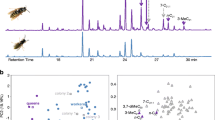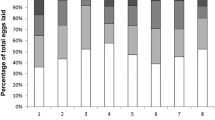Abstract
Queens of the primitively eusocial wasp Ropalidia marginata are behaviourally docile and maintain their reproductive monopoly by rubbing their abdomen and applying a pheromone to the nest surface. We argued that the queen should be overthrown if she is prevented from applying her pheromone. To test this prediction we introduced the queen and her workers into a cage without the nest, thereby removing the substrate for pheromone application. Contrary to our expectation, queens maintained their status (in six out of seven experiments), by continuing to rub their abdomens (and presumably applying pheromone) to cage walls even in absence of the nest. Such attempts to apply pheromone to the cage are expected to be relatively inefficient as the surface area would be very large. Thus we found that the queens were aggressively challenged by the workers and they in turn reciprocated with aggression toward their workers. Such aggressive queen-worker interactions are almost nonexistent in natural colonies and were also not recorded in the control experiments (with nests present). Our results reinforce the idea that pheromone helps R. marginata queens maintain their status and more importantly, they also show that, if necessary, queens can also supplement the pheromone with physical aggression.

Similar content being viewed by others
References
Bhadra A., Iyer P.L., Sumana A., Deshpande S.A., Ghosh S. and Gadagkar R. 2007. How do workers of the primitively eusocial wasp Ropalidia marginata detect the presence of their queens? J. theor. Biol. 246: 574-582
Bhadra A., Mitra A., Deshpande S.A., Chandrasekhar K., Naik D.G., Hefetz A. and Gadagkar R. 2010. Regulation of reproduction in the primitively eusocial wasp Ropalidia marginata: on the trail of the queen pheromone. J. Chem. Ecol. 36: 424-431
Chandrashekara K. and Gadagkar R. 1991. Behavioural castes, dominance and division of labour in a primitively eusocial wasp. Ethology 87: 269-283
Dapporto L., Bruschini C., Cervo R., Petrocelli I. and Turillazzi S. 2010. Hydrocarbon rank signatures correlate with differential oophagy and dominance behaviour in Polistes dominulus foundresses. J. Exp. Biol. 213: 453-458
Dapporto L., Dani F.R. and Turillazzi S. 2007. Social dominance moulds cuticular and egg chemical blends in a paper wasp. Curr. Biol. 17: R504
Fletcher D.J.C. and Ross K.G. 1985. Regulation of reproduction in eusocial Hymenoptera. Annu. Rev. Entomol. 30: 319-343
Free J.B. 1987. Pheromones of Social Bees. Chapman and Hall Limited, London.
Gadagkar R. 2001. The Social Biology of Ropalidia marginata: Toward Understanding the Evolution of Eusociality. Cambridge, MA: Harvard University Press.
Gadagkar R., Chandrashekara K., Chandran S. and Bhagavan S. 1993. Serial polygyny in the primitively eusocial wasp Ropalidia marginata: Implications for the evolution of sociality. In: Queen Number and Sociality in Insects (Keller L., Ed). Oxford University Press, Oxford, pp 188-214
Kardile S.P. and Gadagkar R. 2002. Docile sitters and active fighters in paper wasps: a tale of two queens. Naturwissenschaften 89: 176-179
Katzav-Gozansky T., Boulay R., Soroker V. and Hefetz A. 2004. Queen-signal modulation of worker pheromonal composition in honeybees. Proc. R. Soc. Lond. B 271: 2065-2069
Keller L. and Nonacs P. 1993. The role of queen pheromones in social insects: queen control or queen signal? Anim. Behav. 45: 787-794
Le Conte Y. and Hefetz A. 2008. Primer pheromones in social Hymenoptera. Annu. Rev. Entomol. 53: 523-542
Mitra A. and Gadagkar R. 2011. Can Dufour’s gland compounds honestly signal fertility in the primitively eusocial wasp Ropalidia marginata? Naturwissenschaften 98: 157-161
Pardi L. 1948. Dominance order in Polistes wasps. Physiol. Zool. 21: 1-13
Premnath S., Sinha A. and Gadagkar R. 1996. Dominance relationship in the establishment of reproductive division of labour in a primitively eusocial wasp (Ropalidia marginata). Behav. Ecol. Sociobiol. 39: 125-132
R Development Core Team 2010. R: A Language and Environment for Statistical Computing, Version: 2.10.1, R Foundation for Statistical Computing, Vienna, Australia, ISBN: 3-900051-07-0, url: http://R-project.org
Röseler P.-F., Röseler I. and Strambi A. 1986. Studies of the dominance hierarchy in the paper wasp, Polistes gallicus (L.) (Hymenoptera Vespidae). Mon. Zool. Ital. 20: 283-290
Shakarad M. and Gadagkar R. 1995. Colony founding in the primitively eusocial wasp, Ropalidia marginata (Hymenoptera: Vespidae). Ecol. Entomol. 20: 273-282
Sumana A. and Gadagkar R. 2003. Ropalidia marginata - a primitively eusocial wasp society headed by behaviourally non-dominant queens. Curr. Science 84: 1464-1468
West-Eberhard M.J. 1969. The social biology of polistine wasps. Misc. Publ. Mus. Zool., Univ. Michigan 140: 1-101
Acknowledgments
This work was supported by grants from the Department of Science and Technology, the Department of Biotechnology, the Council of Scientific and Industrial Research, and the Ministry of Environment and Forest, Government of India. We thank Anandarup Bhadra and Yuko Ulrich for participating in some of the observations. PS, KNB, JNK, KS, and AP carried out behavioural observations. PS analysed the data. This paper was co-written by PS and RG, and RG supervised the whole work. Our experiments comply with regulations of animal care in India.
Author information
Authors and Affiliations
Corresponding author
Rights and permissions
About this article
Cite this article
Saha, P., Balasubramaniam, K.N., Kalyani, J.N. et al. Clinging to royalty: Ropalidia marginata queens can employ both pheromone and aggression. Insect. Soc. 59, 41–44 (2012). https://doi.org/10.1007/s00040-011-0185-7
Received:
Revised:
Accepted:
Published:
Issue Date:
DOI: https://doi.org/10.1007/s00040-011-0185-7




